
In the material culture of classical antiquity, a phiale or patera is a shallow ceramic or metal libation bowl. It often has a bulbous indentation in the center underside to facilitate holding it, in which case it is sometimes called a mesomphalic phiale. It typically has no handles, and no feet. Although the two terms may be used interchangeably, particularly in the context of Etruscan culture, phiale is more common in reference to Greek forms, and patera in Roman settings, not to be confused with the Greek (Πατέρας) Patéras or Father.

Syrtis Major Planum is a "dark spot" located in the boundary between the northern lowlands and southern highlands of Mars just west of the impact basin Isidis in the Syrtis Major quadrangle. It was discovered, on the basis of data from Mars Global Surveyor, to be a low-relief shield volcano, but was formerly believed to be a plain, and was then known as Syrtis Major Planitia. The dark color comes from the basaltic volcanic rock of the region and the relative lack of dust.

Kenneth Wayne Patera is an American retired professional wrestler, Olympic weightlifter, and strongman competitor from the United States.
John Arlen Patera was an American football player and coach in the National Football League. He played for the Baltimore Colts,Chicago Cardinals, and Dallas Cowboys, and was an assistant coach for the Los Angeles Rams,New York Giants, and Minnesota Vikings. Patera was the first head coach of the Seattle Seahawks, with a career head coaching record of 35–59–0 (.372), all with the Seahawks.

Cleopatra, initially called Cleopatra Patera, is an impact crater on Venus, in Maxwell Montes.
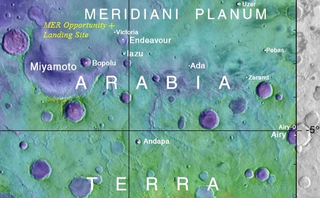
Arabia Terra is a large upland region in the north of Mars that lies mostly in the Arabia quadrangle, but a small part is in the Mare Acidalium quadrangle. It is densely cratered and heavily eroded. This battered topography indicates great age, and Arabia Terra is presumed to be one of the oldest terrains on the planet. It covers as much as 4,500 km (2,800 mi) at its longest extent, centered roughly at 21°N6°E with its eastern and southern regions rising 4 km (13,000 ft) above the north-west. Alongside its many craters, canyons wind through the Arabia Terra, many emptying into the large northern lowlands of the planet, which borders Arabia Terra to the north.
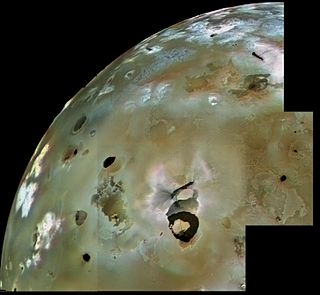
Loki Patera is the largest volcanic depression on Jupiter's moon Io, 202 kilometres (126 mi) in diameter. It contains an active lava lake, with an episodically overturning crust. The level of activity seen is similar to a superfast spreading mid-ocean ridge on Earth. Temperature measurements of thermal emission at Loki Patera taken by Voyager 1's Infrared Interferometer Spectrometer and Radiometer (IRIS) instrument were consistent with sulfur volcanism.

Biblis Tholus is an extinct Martian volcano located at 2.55°N 235.62°E, one of two volcanoes near the center of the Tharsis volcanism. Along with Ulysses Tholus, it is almost midway between Olympus Mons and the Tharsis Montes. Biblis Tholus lies in the Tharsis quadrangle. It is approximately 170 kilometers (110 mi) long and 100 kilometers (62 mi) wide, rising about 3 kilometers (1.9 mi) from its surroundings.

Gish Bar Patera is a patera, or a complex crater with scalloped edges, on Jupiter's moon Io. It is 106.3 by 115.0 kilometers and 9,600 km2 in area. It is located at 16.18°N 90.26°W. It is named after the Babylonian sun god Gish Bar. Its name was approved by the International Astronomical Union in 1997. It is located at the southern base of Gish Bar Mons, an 11-kilometer-high mountain. To the northeast is Skythia Mons, and to the east is Monan Mons, at the north and south ends of which are Monan Patera and Ah Peku Patera.

Svarog Patera is a patera, or a complex crater with scalloped edges, on Jupiter's moon Io. It is 124 kilometers in diameter and is located at 48.66°S 265.74°W. It is named after the Russian smith god Svarog. Its name was approved by the International Astronomical Union in 1979. Svarog Patera is a Voyager spacecraft-detected hot spot. North of Svarog Patera is Lyrcea Planum, north of which is Babbar Patera. To the south is Silpium Mons, and to the east is Hermes Mensa. To the southeast are Pyerun Patera and Epaphus Mensa.

Apollinaris Mons is an ancient shield volcano in the southern hemisphere of Mars. It is situated near the equator, south of Elysium Planitia and north of the impact crater Gusev. Elysium Planitia separates it from the volcanic province of Elysium to its northwest. The volcano's caldera is named Apollinaris Patera; this name formerly applied to the whole edifice.
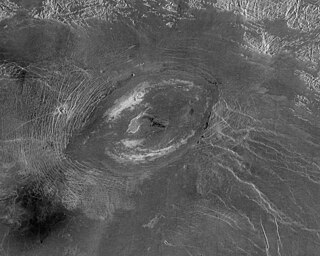
Sacajawea Patera is a large, elongate caldera located in Western Ishtar Terra on the smooth plateau of Lakshmi Planum, on the planet Venus. The image is centred at 64.5 degrees North latitude and 337 degrees East longitude. It is approximately 420 km (260 mi) wide at the base. Sacajawea is a depression approximately 1–2 kilometres deep and 120 x 215 kilometres in diameter; it is elongate in a southwest-northeast direction. The depression is bounded by a zone of circumferential curvilinear structures interpreted to be graben and fault scarps. These structures are spaced 0.5–4 kilometers apart, are 0.6–4.0 kilometers in width and up to 100 km (62 mi) in length. Extending up to approximately 140 km (87 mi) in length from the southeast of the patera is a system of linear structures thought to represent a flanking rift zone along which the lateral injection and eruption of magma may have occurred. A shield edifice 12 km (7.5 mi) in diameter with a prominent central pit lies along the trend of one of these features.

Tyrrhenus Mons, formerly Tyrrhena Mons or Tyrrhena Patera, is a large volcano in the Mare Tyrrhenum quadrangle of Mars, located at 21.36° south latitude and 253.47° west longitude. The name "Tyrrhena Patera" now refers only to the central depression, a volcanic crater or caldera. It was named after a classical albedo feature name. Pit chains are found at the summit of Tyrrhenus Mons. They are formed by collapse of material into underground voids. Since they form chains and concentric fractures that are aligned, they are probably caused by extension of the surface. Volcanic processes made the crust pull apart. Voids were formed, then material fell into them, leaving holes. It is one of the oldest volcanoes on Mars. As a consequence of its old age, Tyrrhenus Mons has many radiating gullies on its slope. When it was formed, magma may have gone through frozen ground and then erupted as easily eroded ash, instead of lava flows.
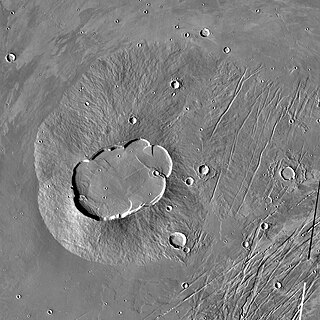
Uranius Mons, formerly Uranius Patera, is a volcano on Mars located in the Tharsis quadrangle, named after a classical albedo feature. The name "Uranius Patera" now refers only to the volcano's central caldera. It is 4,853 metres (15,922 ft) high and has shallow slopes. It belongs to the Uranius group of volcanoes in the Tharsis area. The sides of Uranius Mons consist of radial lava flows; the large caldera (90×65 km) is elongated in the southwestern direction. The surrounding plains are younger and part of the Tharsis Montes Formation of the Amazonian epoch.

Tupan Patera is an active volcano on Jupiter's moon Io. It is located on Io's anti-Jupiter hemisphere at 18.73°S 141.13°W. Tupan consists of a volcanic crater, known as a patera, 79 kilometers across and 900 meters deep. The volcano was first seen in low-resolution observations by the two Voyager spacecraft in 1979, but volcanic activity was not seen at this volcano until June 1996 during the Galileo spacecraft's first orbit. Following this first detection of near-infrared thermal emission and subsequent detections by Galileo during the next few orbits, this volcano was formally named Tupan Patera, after the thunder god of the Tupí-Guaraní indigenous peoples in Brazil, by the International Astronomical Union in 1997.

Orcus Patera is a region on the surface of the planet Mars first photographed by Mariner 4. Of unknown formation, whether by volcanic, tectonic, or cratering causes, the region includes a depression about 380 kilometres long, 140 kilometres wide, surrounded by a rim up to 1.8 kilometres high.
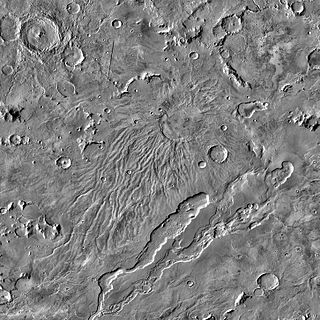
Hadriacus Mons is an ancient, low-relief volcanic mountain on the planet Mars, located in the southern hemisphere just northeast of the impact basin Hellas and southwest of the similar volcano Tyrrhenus Mons. Hadriacus Mons is in the Hellas quadrangle. It has a diameter of 450 kilometres (280 mi). The name was approved in 2007. The flanks of Hadriacus Mons have been eroded into gullies; its southern slopes are incised by the outflow channel Dao Vallis. The large extent of volcanic deposits and the caldera size leads some researchers to suggest that these features were the result of an explosive event caused by a contact between magma and groundwater.

Eden Patera is a feature located in the Mare Acidalium quadrangle on the planet Mars. In October 2013 the feature gained some attention when it was speculated it may be a supervolcano rather than an impact crater, according to research from the Planetary Science Institute in Tucson, led by Joseph R. Michalski. The research postulated the crater was formed by the volcano's caldera collapsing, rather than from an impact. Some of reasons for suspecting that Eden Patera is a collapsed caldera not an impact crater are its irregular shape, an apparent lack of a raised rim or central peak, and lack of impact ejecta.

Nili Patera is a dune field on Mars. It is located on top of a lava bed, at the site of an ancient volcano, the Nili Patera caldera of Syrtis Major, near the Martian equator, and it is one of the most active dune fields of Mars. Its location coordinates on Mars are 8.7° N latitude, 67.3° E longitude. It is being actively studied by the HiRISE camera, on board the Mars Reconnaissance Orbiter, at the rate of one image every six weeks. The study of the movement of the dunes provides information regarding wind variation as a function of time and furthers the study of surface erosion characteristics of the Martian landscape. This information can then be used for the development and design of future Mars expeditions. The dunes of the Patera field are of the barchan type and their study by HiRISE was the first one to establish dune and ripple movement of a minimum of 1 metre on Mars. The Patera dune field, was also the first to be investigated using the COSI-Corr software, which was originally developed to analyse the movement of earthbound dunes. The research results from the evidence provided by the monitoring of the Nili Patera field, indicate sand fluxes of the order of several cubic metres per metre per year, similar to the flux observed at the sand dunes of Victoria Valley in Antarctica.



















